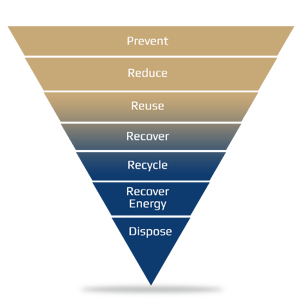Almost every discussion of recycling and sustainable energy nowadays leads us to a discussion of the “circular economy”. But what is the circular economy? Why is it good? And what does the UAE need to achieve a circular economy?
What is a circular economy and why do we need it?
A circular economy is one that prevents waste, pollution, and depletion of resources by closing the loop on the flow of resources through reduction, reuse, and recycling. This is in contrast to a linear economy where we produce using new resources, consume, and dispose into landfills.
The dividends of a true circular economy extend beyond environmental benefits. When a nation transitions into a circular economy it creates a more sustainable future for generations to come, and at the same time increases the competitiveness of its economy. In the case of the UAE for example, research from the World Economic Forum states that a move toward a circular economy could generate $4.5tn (AED16.5tn) in additional economic output by 2030. That is the kind of impact and growth we can expect with this type of economy.
How is a circular economy achieved?
 Achieving a circular economy requires a fundamental shift in thinking and economic planning on the highest level. There is no single entity that can achieve such agenda alone. It requires a concerted, consistent, and coordinated effort from government departments, environmental agencies, municipalities, regulators, public and private sectors, and even citizens.
Achieving a circular economy requires a fundamental shift in thinking and economic planning on the highest level. There is no single entity that can achieve such agenda alone. It requires a concerted, consistent, and coordinated effort from government departments, environmental agencies, municipalities, regulators, public and private sectors, and even citizens.
To fully understand the scale of change required we can revisit the waste hierarchy. This diagram illustrates the various stages that can benefit from the introduction of sustainable practices, new technologies, and alternative methods.
At the upper part of the hierarchy, the circular economy can be fostered through practices such as sustainable materials planning and management, sustainable import, sustainable manufacturing, resource efficiency, and circular economy policies.
The upper part of the hierarchy is where the real paradigm shift can take place. If the circular economy agenda is promoted as an opportunity and backed with the right funding programmes, nations can create a green field for technological and business innovation around creating and designing products that are cyclical by nature. This can spur new businesses and industries that can create more jobs and prosperity.
Going down the hierarchy, 3R policies (reduce, reuse, recycle) can go a long way in supporting the circular economy as they get adopted on a wider scale by both businesses and consumers.
Material recovery, waste-to-energy, and waste-to-resources facilities play a critical part at the lower part of the hierarchy by feeding back into the top and reducing the unacceptable waste going to landfills to the absolute minimum.
What is the status of circular economy in the UAE?
There is certainly no shortage of vision in the UAE when it comes to building a circular economy. In late 2019, the UAE government kicked off the Scale 360 initiative in collaboration with the World Economic Forum (WEF) aimed at implementing technology innovations that result in a circular economy. The initiative gives the UAE access to the WEF’s networks of experts, civil society, government, and industry leaders.
The UAE’s plan for building a circular economy involves connecting entrepreneurs and innovations through nationally-led challenges and partnerships. The unique idea behind this is to help stakeholders scale up solutions in partnership with government entities, impact investors, experts, and companies.
Dr Thani Ahmed Al Zeyoudi, Minister of Climate Change and Environment, stresses the importance of achieving a circular economy: “In addition to ensuring the conservation of our natural resources, a circular economy will step up our reliance on clean energy, enhance the consistent implementation of sustainable development standards, and generate greater opportunities for the youth in the region.”
Just like most similar initiatives around the world, the UAE’s circular economy initiative goes under the Environment and Energy agenda of the UAE government overlapping with the sub-agendas of waste management, sustainability, renewable energy, and climate change.
On the waste management front, the UAE Vision 2021 aims to reduce the amount of waste currently going to landfills by 75%. Dubai in particular aims to reduce the waste sent to landfills to zero in twenty years. Material recovery facilities (MRFs) like Farz from Imdaad Group are now capable of recovering up to 30% of municipal solid waste streams to produce high-grade recyclable materials. Mega projects for waste-to-energy are underway in Dubai, Abu Dhabi, and Sharjah. Once completed, these facilities combined can generate over 140 megawatts of electricity out of municipal solid waste that is processed by MRFs.
At the same time, 3R policies are gradually rolled out across the country to support the agenda. Both Dubai and Abu Dhabi are set to ban single-use plastic starting next year.
The Ministry of Climate Change and Environment formed a coalition with select government and private entities pushing forth a circular economy, focused on piloting a ‘closed-loop recycling model’ for plastic bottles, beverage cartons, and other packaging in Abu Dhabi.
In both the public and private sector, we continue to see green initiatives that contribute to achieving a circular economy. Examples include Emirates Global Aluminium (EGA) recycling its 33,000 metric tonnes of SPL hazardous waste generated every year; Gulf Cement in Ras Al Khaimah using camel manure to generate fossil fuel for making cement and saving 18,000 tonnes of carbon emissions; and Etuix, a fashion line that aims at upcycling the 500 tonnes of PVC material used and destroyed by the advertising industry in Dubai every year.
In summary, there are numerous efforts and steps in the right direction, but it takes more collaboration and coordination to speed up the progress towards a circular economy in the UAE.
How can Material Recovery Facilities (MRFs) help?
Recycling is a pre-condition for the circular economy, and it applies mainly to solid waste. Recycling solid waste requires separation and extraction of useful materials that can be recycled. In the case of industrial and construction waste the separation process usually takes place on-site. However, in the case of waste collected by municipalities from residential communities and business districts, also known as municipal solid waste, the separation and extraction of materials requires a more complex process that is usually carried out at a Material Recovery Facility (MRF).
In most countries, MRFs are a privatized activity, sometimes subsidized, and sometimes coupled with waste collection services, and that’s mainly because governments may not have the capacity to handle all the municipal solid waste by themselves, especially in countries that are densely populated or geographically spread out.
Farz MRF in the UAE
In the UAE, Farz MRF is considered one of the leading facilities. Farz was launched by Imdaad Group at the beginning of 2020. The facility spans an area of 45,322 m2 and features two lines capable of handling 1,200 tonnes per day of municipal solid waste. At full capacity, the facility is able to eliminate 19,250 kgs of CO2 emissions per day.
Farz employs the latest technologies and uses a variety of trommels, magnetic, optical, and ballistic separators to extract useful materials out of the waste stream. Such materials include metals, both ferrous and non-ferrous, plastics and polymers, waste paper, and glass. They are the final output of the facility and they get baled and stored until they are shipped out to buyers.
We expect that most of Farz MRF’s exports in the beginning will go to export because of low demand locally. However, we expect this to change as we move closer to a circular economy.
Take a tour of Farz MRF
We are organizing educational and business tours of our Farz MRF to select audiences. To learn more and request a tour please visit this page and fill in the form.

